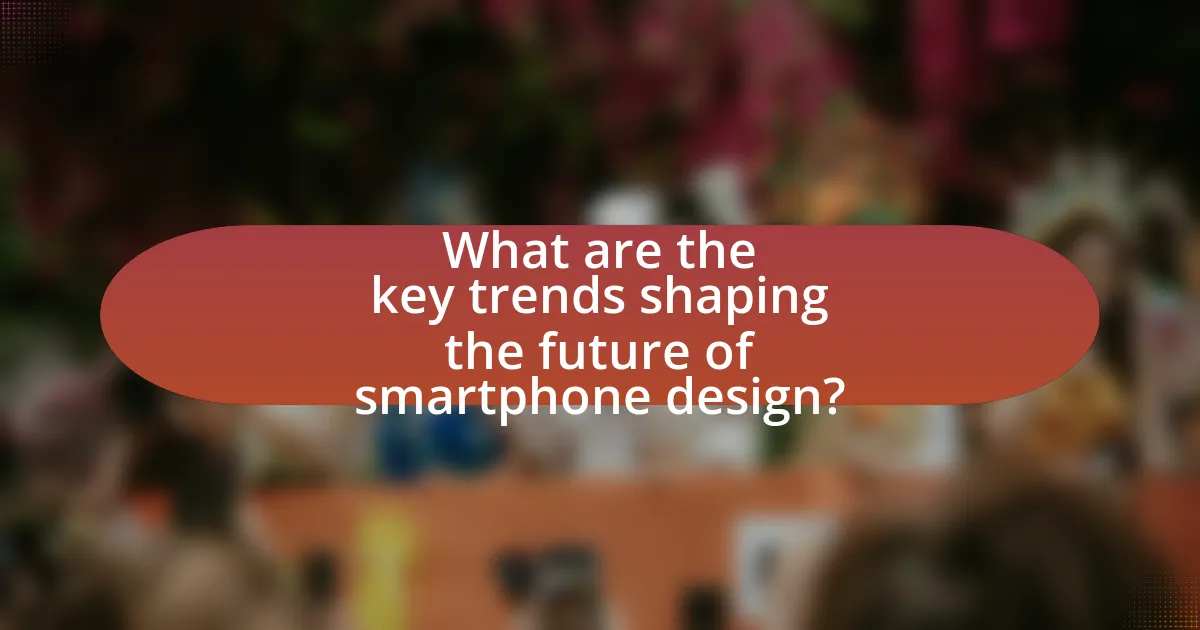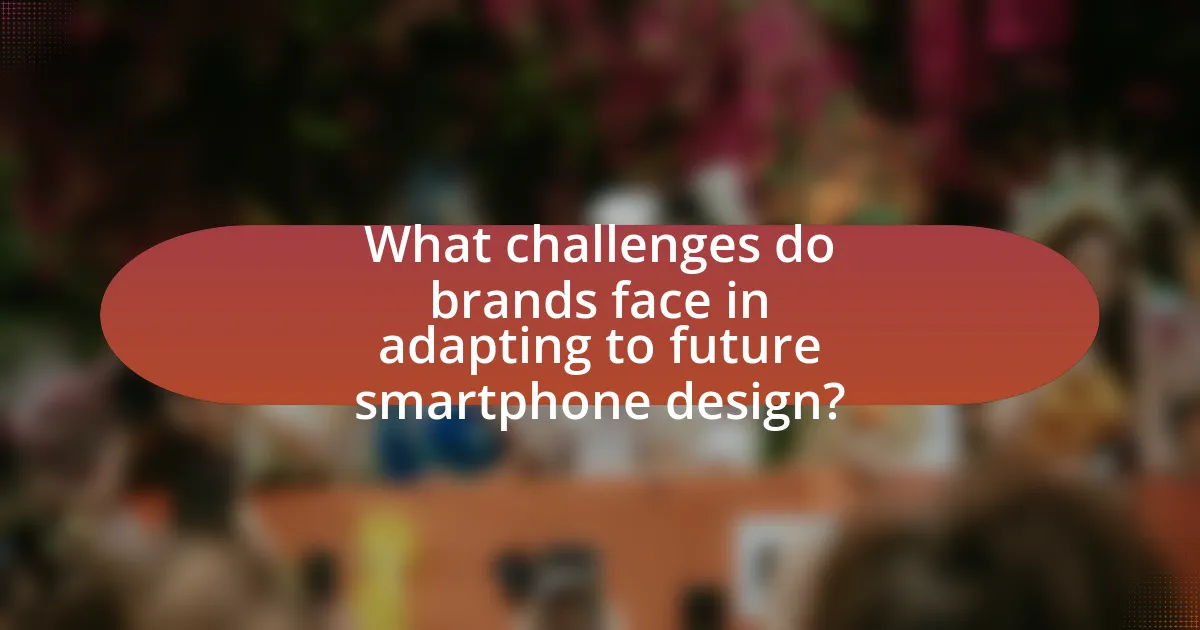The article focuses on the future of smartphone design, highlighting key trends such as foldable displays, enhanced camera technology, and the use of sustainable materials. It examines how consumer behavior influences design choices, with an emphasis on features like camera quality, battery life, and 5G connectivity. Additionally, the article discusses the impact of demographic shifts, technological advancements, and sustainability concerns on design preferences. It also addresses the challenges brands face in adapting to these trends, the importance of regulatory compliance, and best practices for innovation in smartphone design. Overall, the article provides a comprehensive overview of the factors shaping the evolution of smartphones in response to consumer demands and market dynamics.

What are the key trends shaping the future of smartphone design?
The key trends shaping the future of smartphone design include foldable displays, enhanced camera technology, and sustainable materials. Foldable displays allow for larger screens in compact devices, as seen in models like the Samsung Galaxy Z Fold, which has gained significant market interest since its release. Enhanced camera technology, such as multi-lens systems and AI-driven photography, is becoming standard, with brands like Apple and Google leading the way in computational photography. Additionally, the use of sustainable materials is on the rise, with companies like Fairphone promoting eco-friendly designs to appeal to environmentally conscious consumers. These trends reflect the industry’s response to consumer demands for innovation, functionality, and sustainability.
How is consumer behavior influencing smartphone design?
Consumer behavior significantly influences smartphone design by dictating features, aesthetics, and functionality that align with user preferences. For instance, the increasing demand for larger screens has led manufacturers to adopt edge-to-edge displays, as seen in models like the iPhone 14 and Samsung Galaxy S23, which cater to consumer desires for immersive experiences. Additionally, the rise in health-conscious consumers has prompted brands to integrate fitness tracking and health monitoring features, as evidenced by the popularity of devices like the Apple Watch. Furthermore, sustainability concerns have driven companies to explore eco-friendly materials and production processes, reflecting a shift in consumer values towards environmental responsibility. This alignment between consumer expectations and design choices illustrates how market trends directly shape the evolution of smartphone technology.
What features are consumers prioritizing in new smartphones?
Consumers are prioritizing camera quality, battery life, and 5G connectivity in new smartphones. Research indicates that 84% of consumers consider camera performance crucial, with features like multiple lenses and high megapixel counts being highly sought after. Additionally, 75% of users emphasize the importance of battery longevity, preferring devices that can last a full day on a single charge. Furthermore, the demand for 5G connectivity has surged, with 65% of consumers indicating it as a key factor in their purchasing decisions, reflecting the growing reliance on faster internet speeds for various applications.
How do demographic shifts affect design preferences?
Demographic shifts significantly influence design preferences by altering consumer needs and aesthetic values. For instance, as populations age, there is a growing demand for user-friendly interfaces and larger text sizes in smartphone design to accommodate older users. Conversely, younger demographics often favor sleek, minimalist designs and advanced technology features, reflecting their tech-savvy nature. According to a report by Pew Research Center, millennials and Gen Z prioritize functionality and sustainability in their purchasing decisions, which drives brands to incorporate eco-friendly materials and innovative features in their designs. Thus, understanding these demographic trends allows brands to tailor their products effectively to meet the evolving preferences of diverse consumer groups.
What technological advancements are impacting smartphone design?
Technological advancements significantly impacting smartphone design include foldable displays, 5G connectivity, and enhanced camera systems. Foldable displays allow for larger screens in compact devices, exemplified by models like Samsung Galaxy Z Fold, which has seen increased consumer interest since its launch in 2019. 5G connectivity enhances data speeds and supports new applications, driving manufacturers to design devices that can leverage this technology, as evidenced by the rapid rollout of 5G-capable smartphones since 2020. Additionally, advancements in camera technology, such as multi-lens setups and AI enhancements, have transformed smartphone photography, with brands like Apple and Google leading the way in integrating sophisticated imaging capabilities into their designs.
How are materials science innovations changing smartphone aesthetics?
Materials science innovations are significantly enhancing smartphone aesthetics by introducing advanced materials that improve both functionality and visual appeal. For instance, the use of ceramic materials and glass composites allows for sleeker designs while maintaining durability, as seen in models like the Apple iPhone 12, which features a Ceramic Shield front cover that is both aesthetically pleasing and four times more resistant to drops than previous glass designs. Additionally, innovations such as flexible OLED displays enable manufacturers to create edge-to-edge screens that maximize display area, contributing to a modern and minimalist look. These advancements not only elevate the visual aspects of smartphones but also influence consumer preferences, driving brands to adopt these materials to remain competitive in the market.
What role does artificial intelligence play in smartphone functionality?
Artificial intelligence enhances smartphone functionality by enabling features such as voice recognition, camera optimization, and predictive text. These capabilities improve user experience by allowing for more intuitive interactions and personalized services. For instance, AI-driven algorithms in cameras can analyze scenes and adjust settings automatically, resulting in better image quality. Additionally, virtual assistants like Siri and Google Assistant utilize AI to understand and respond to user commands, streamlining tasks and providing information efficiently. According to a report by Gartner, AI integration in smartphones is expected to increase user engagement and satisfaction, demonstrating its critical role in modern smartphone design.
Why is sustainability becoming a crucial factor in smartphone design?
Sustainability is becoming a crucial factor in smartphone design due to increasing consumer demand for environmentally friendly products. Research indicates that 66% of global consumers are willing to pay more for sustainable brands, highlighting a significant market shift towards eco-conscious purchasing. Additionally, regulatory pressures and the need to reduce electronic waste are driving manufacturers to adopt sustainable practices, such as using recyclable materials and designing for longevity. The smartphone industry is responsible for substantial carbon emissions, prompting companies to innovate in energy-efficient production and supply chain management to mitigate their environmental impact.
What are the environmental impacts of smartphone production?
Smartphone production has significant environmental impacts, primarily due to resource extraction, energy consumption, and electronic waste. The mining of rare minerals, such as lithium and cobalt, leads to habitat destruction and pollution. For instance, lithium extraction in South America has been linked to water depletion in local communities. Additionally, the manufacturing process is energy-intensive, contributing to greenhouse gas emissions; the production of a single smartphone can generate up to 55 kg of CO2 emissions. Finally, the disposal of smartphones contributes to electronic waste, with approximately 50 million tons generated globally each year, often ending up in landfills where toxic substances can leach into the environment.
How can brands implement sustainable practices in design?
Brands can implement sustainable practices in design by prioritizing eco-friendly materials, optimizing production processes, and designing for longevity and recyclability. For instance, using biodegradable plastics or recycled metals reduces environmental impact, while efficient manufacturing techniques can minimize waste and energy consumption. Additionally, designing products that are easy to repair and recycle encourages a circular economy, which is supported by research from the Ellen MacArthur Foundation, highlighting that circular design can significantly reduce resource consumption and waste.

What challenges do brands face in adapting to future smartphone design?
Brands face significant challenges in adapting to future smartphone design, primarily due to rapid technological advancements and changing consumer preferences. The integration of emerging technologies, such as foldable displays and augmented reality, requires brands to invest heavily in research and development to stay competitive. Additionally, sustainability concerns are pushing brands to adopt eco-friendly materials and manufacturing processes, which can complicate design and production timelines. Market saturation and the need for differentiation further complicate the landscape, as brands must innovate while managing costs and maintaining brand identity. These challenges are underscored by the fact that the global smartphone market is projected to reach 1.5 billion units by 2025, intensifying competition among brands to capture consumer attention.
How do market competition and differentiation affect design choices?
Market competition and differentiation significantly influence design choices by compelling brands to innovate and create unique features that stand out. In a saturated smartphone market, companies must differentiate their products to attract consumers, leading to design innovations such as unique form factors, materials, and user interfaces. For instance, Apple’s emphasis on minimalist design and premium materials has set a standard that competitors strive to match or exceed, driving overall design evolution in the industry. Additionally, research indicates that brands that successfully differentiate their products can achieve higher market share and customer loyalty, as seen with Samsung’s diverse range of models catering to various consumer preferences.
What strategies can brands use to stand out in a saturated market?
Brands can stand out in a saturated market by focusing on unique value propositions, innovative design, and personalized customer experiences. Unique value propositions differentiate a brand from competitors by highlighting specific benefits or features that resonate with target audiences. For instance, Apple has successfully differentiated itself through its ecosystem of products and services, creating a loyal customer base. Innovative design, such as incorporating sustainable materials or cutting-edge technology, can attract consumers looking for modern solutions; companies like Samsung have leveraged this by introducing foldable smartphones that offer new functionalities. Lastly, personalized customer experiences, achieved through data-driven marketing and tailored services, enhance brand loyalty; research shows that 80% of consumers are more likely to make a purchase when brands offer personalized experiences. These strategies collectively enable brands to carve out a distinct identity in crowded markets.
How does pricing influence design decisions?
Pricing significantly influences design decisions by dictating the materials, features, and overall quality of a product. For instance, a higher price point allows brands to invest in premium materials and advanced technology, leading to innovative designs that enhance user experience. Conversely, a lower price point often necessitates cost-cutting measures, which can limit design options and result in simpler, less feature-rich products. Research indicates that consumers are willing to pay more for designs that offer perceived value, such as durability and aesthetics, which further reinforces the connection between pricing and design choices.
What regulatory considerations must brands keep in mind?
Brands must keep in mind compliance with data protection regulations, environmental laws, and consumer safety standards. Data protection regulations, such as the General Data Protection Regulation (GDPR) in Europe, require brands to ensure user data privacy and security. Environmental laws mandate adherence to waste management and recycling protocols, particularly concerning hazardous materials in smartphones. Consumer safety standards, enforced by organizations like the Consumer Product Safety Commission (CPSC) in the United States, necessitate that brands ensure their products are safe for use and free from defects. These regulatory considerations are crucial for maintaining legal compliance and fostering consumer trust.
How do international regulations impact design and manufacturing?
International regulations significantly impact design and manufacturing by establishing standards that ensure safety, quality, and environmental sustainability. These regulations dictate materials used, production processes, and product testing, compelling manufacturers to innovate and adapt their designs to comply with legal requirements. For instance, the European Union’s Restriction of Hazardous Substances (RoHS) directive limits the use of specific hazardous materials in electronic devices, prompting smartphone manufacturers to develop alternative materials and technologies. Compliance with such regulations not only affects the technical specifications of products but also influences market access, as non-compliance can lead to penalties or bans in certain regions.
What are the implications of data privacy laws on smartphone features?
Data privacy laws significantly impact smartphone features by mandating stricter data protection measures and user consent protocols. These regulations, such as the General Data Protection Regulation (GDPR) in Europe, require smartphone manufacturers to implement features that enhance user privacy, such as data encryption, anonymization, and transparent data usage policies. For instance, smartphones must now include options for users to control their data sharing preferences and access their personal information, which directly influences the design and functionality of operating systems and applications. Compliance with these laws not only shapes the technical specifications of smartphones but also affects user trust and brand reputation in a competitive market.

What best practices should brands follow for future smartphone design?
Brands should prioritize user-centric design, sustainability, and technological innovation in future smartphone design. User-centric design involves understanding consumer needs and preferences, which can be achieved through extensive market research and user testing. For instance, a study by Nielsen Norman Group highlights that user experience significantly impacts customer satisfaction and brand loyalty. Sustainability should be integrated by using eco-friendly materials and promoting recycling programs, as evidenced by Apple’s commitment to using recycled aluminum in its products, which has reduced its carbon footprint. Lastly, brands must embrace technological advancements, such as 5G capabilities and AI integration, to enhance functionality and performance, as seen in the rapid adoption of 5G technology across major smartphone manufacturers. These best practices ensure that brands remain competitive and relevant in an evolving market.
How can brands effectively gather consumer feedback for design improvements?
Brands can effectively gather consumer feedback for design improvements by utilizing a combination of surveys, focus groups, and social media engagement. Surveys allow brands to collect quantitative data on consumer preferences and experiences, while focus groups provide qualitative insights through in-depth discussions. Social media platforms enable brands to interact directly with consumers, facilitating real-time feedback and trend analysis. According to a study by the Nielsen Norman Group, user feedback can lead to a 20% increase in user satisfaction when incorporated into design iterations. This evidence underscores the importance of actively seeking consumer input to enhance product design.
What methods are most effective for collecting user insights?
Surveys and interviews are the most effective methods for collecting user insights. Surveys allow brands to gather quantitative data from a large audience, while interviews provide qualitative insights through in-depth conversations. According to a study by the Nielsen Norman Group, user interviews can reveal user motivations and pain points that surveys may not capture, making them invaluable for understanding user needs in smartphone design. Additionally, usability testing offers direct observation of user interactions with prototypes, providing concrete feedback that can guide design improvements.
How can brands incorporate feedback into the design process?
Brands can incorporate feedback into the design process by actively engaging with users through surveys, focus groups, and usability testing. This engagement allows brands to gather insights on user preferences and pain points, which can directly inform design decisions. For instance, a study by Nielsen Norman Group found that usability testing can reveal issues that users face, leading to improved product functionality and user satisfaction. By systematically analyzing this feedback, brands can iterate on their designs, ensuring that the final product aligns with user expectations and enhances the overall user experience.
What role does collaboration play in innovative smartphone design?
Collaboration is essential in innovative smartphone design as it brings together diverse expertise and perspectives, leading to more creative solutions. By integrating input from engineers, designers, marketers, and consumers, companies can identify user needs and technological possibilities more effectively. For instance, Apple’s collaboration with app developers has resulted in a robust ecosystem that enhances user experience, demonstrating how teamwork can drive innovation. Additionally, partnerships between tech firms and research institutions can accelerate advancements in materials and technology, as seen in the development of foldable screens by companies like Samsung and their collaborations with display manufacturers. This synergy not only fosters creativity but also ensures that products meet market demands and technological trends.
How can partnerships with tech companies enhance design capabilities?
Partnerships with tech companies can enhance design capabilities by providing access to advanced technologies and expertise that improve product innovation. For instance, collaborations with software firms can integrate cutting-edge AI and machine learning into design processes, enabling more personalized user experiences. Additionally, partnerships with hardware manufacturers can lead to the development of new materials and components that enhance functionality and aesthetics. According to a report by McKinsey & Company, companies that leverage technology partnerships can achieve up to 30% faster product development cycles, demonstrating the tangible benefits of such collaborations in the design landscape.
What benefits do cross-industry collaborations offer in design innovation?
Cross-industry collaborations in design innovation enhance creativity, accelerate problem-solving, and foster diverse perspectives. By integrating knowledge and expertise from different sectors, companies can develop unique solutions that may not emerge within a single industry. For instance, the collaboration between technology and fashion industries has led to innovative wearable devices that combine functionality with aesthetic appeal, exemplified by partnerships like Apple and Hermès. Such collaborations can also lead to increased market reach and customer engagement, as they attract a broader audience by merging distinct brand identities and values.
What are the key takeaways for brands looking to innovate in smartphone design?
Brands looking to innovate in smartphone design should prioritize user-centric features, sustainability, and advanced technology integration. User-centric features enhance the overall experience, as evidenced by the success of smartphones that focus on ergonomics and intuitive interfaces, leading to increased customer satisfaction. Sustainability is increasingly important; a report from the Global System for Mobile Communications (GSMA) indicates that 70% of consumers prefer brands that demonstrate environmental responsibility. Advanced technology integration, such as AI and 5G capabilities, is crucial for staying competitive, as these technologies are projected to drive significant market growth, with the global AI in the smartphone market expected to reach $20 billion by 2025.




